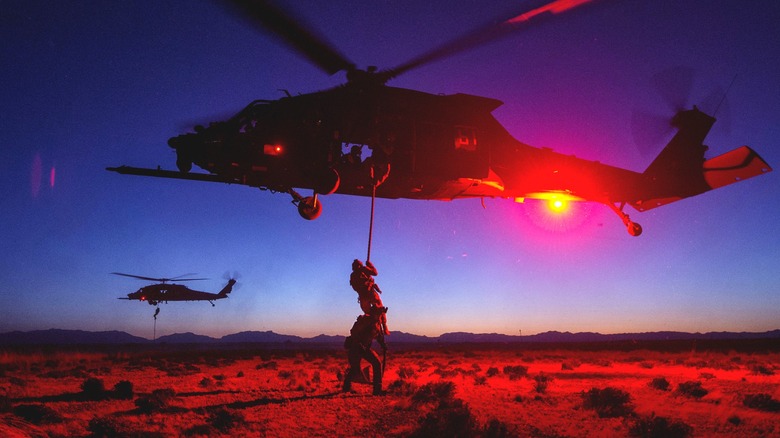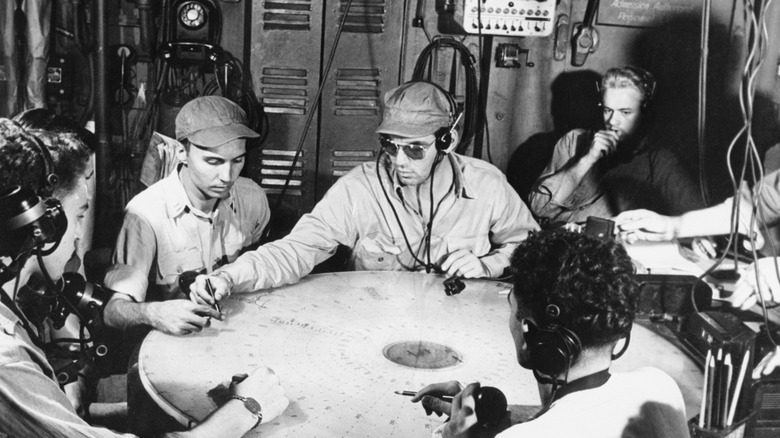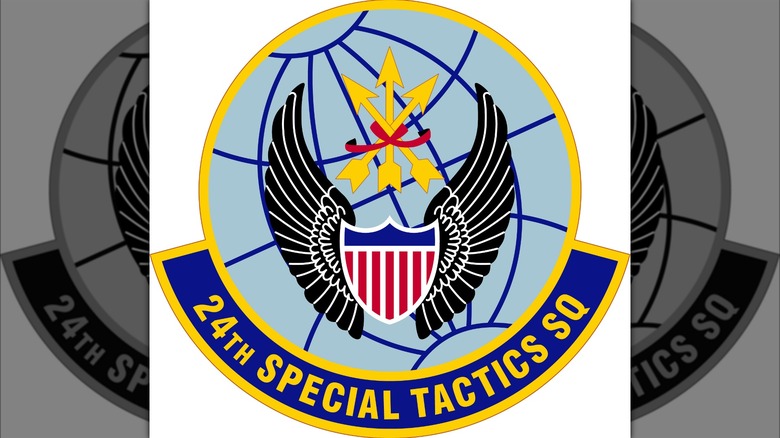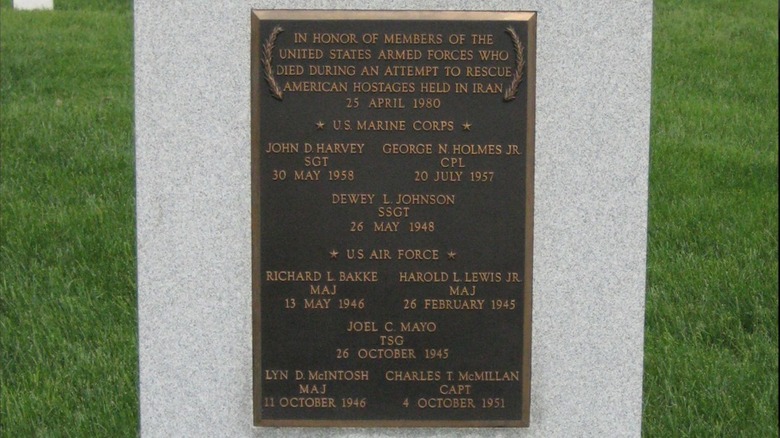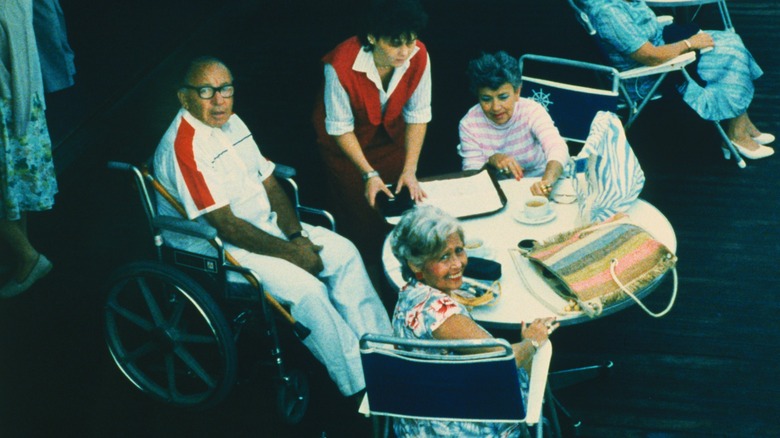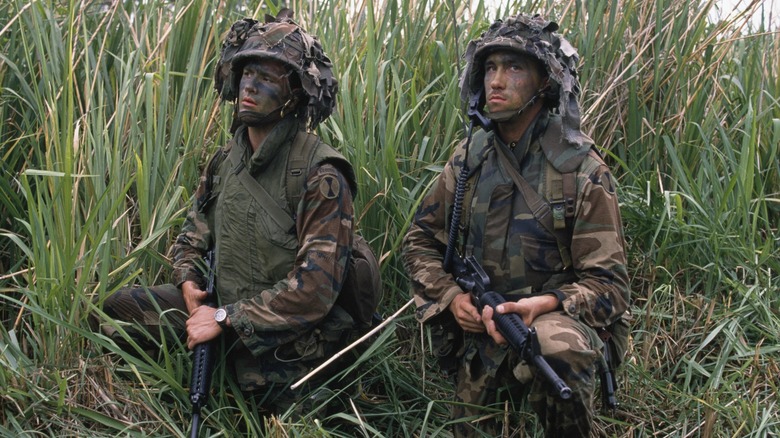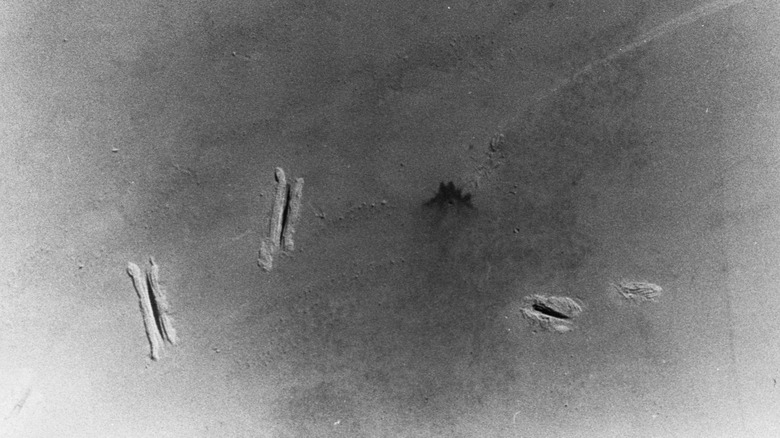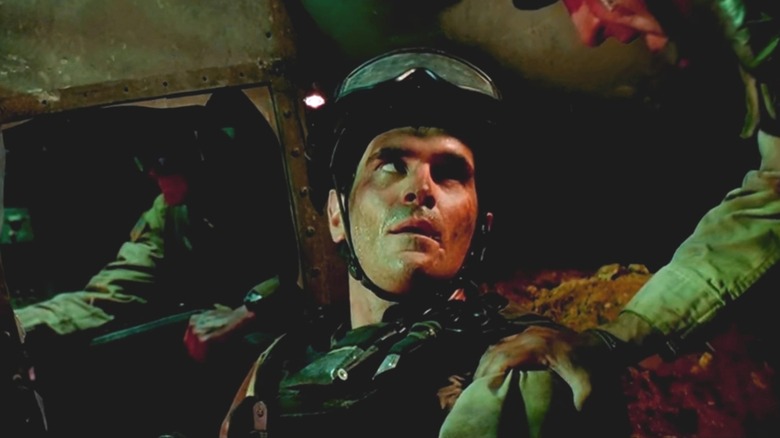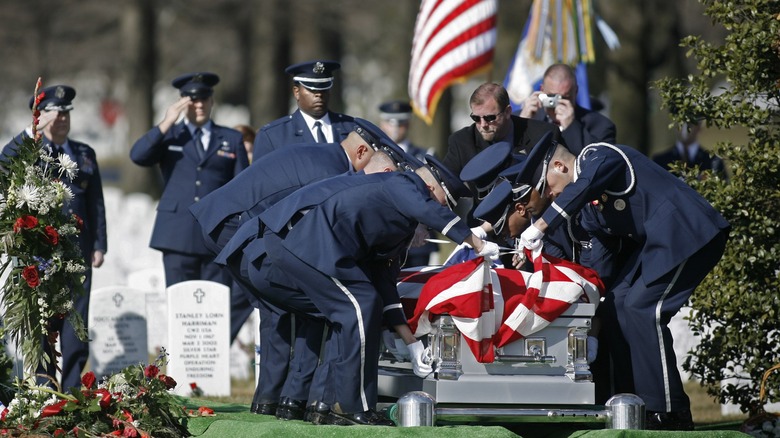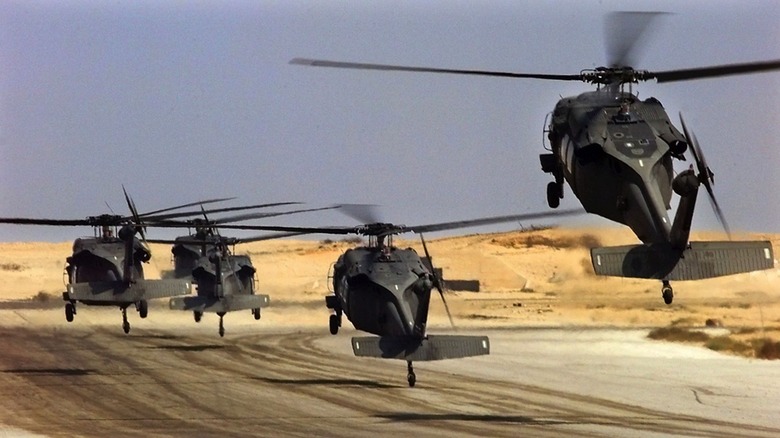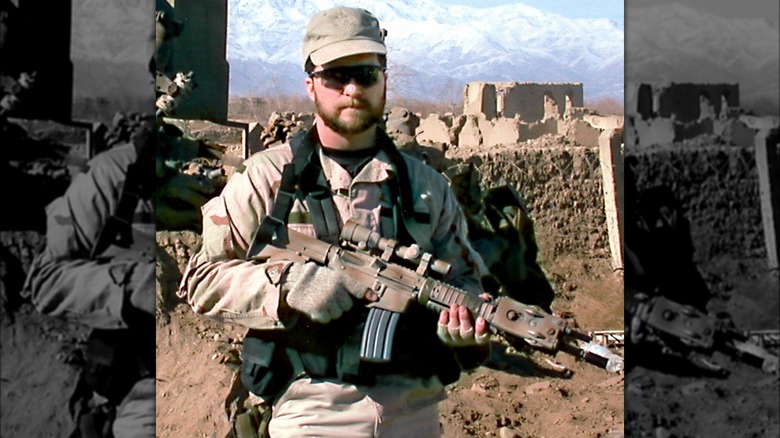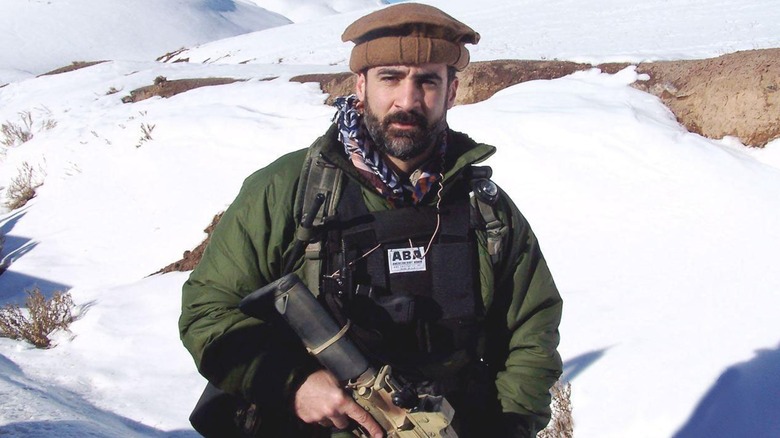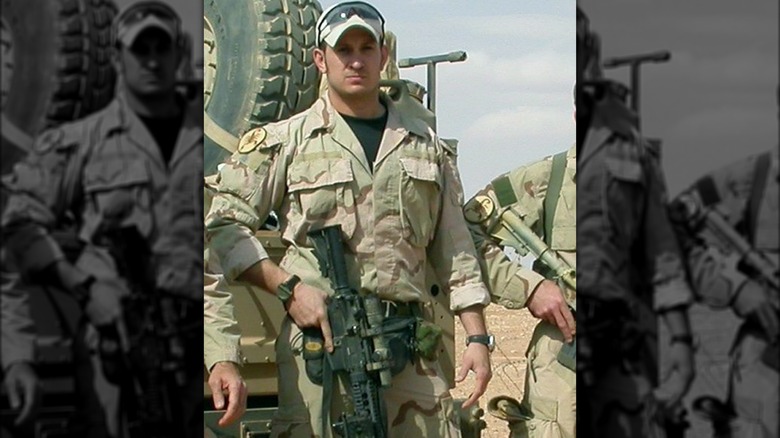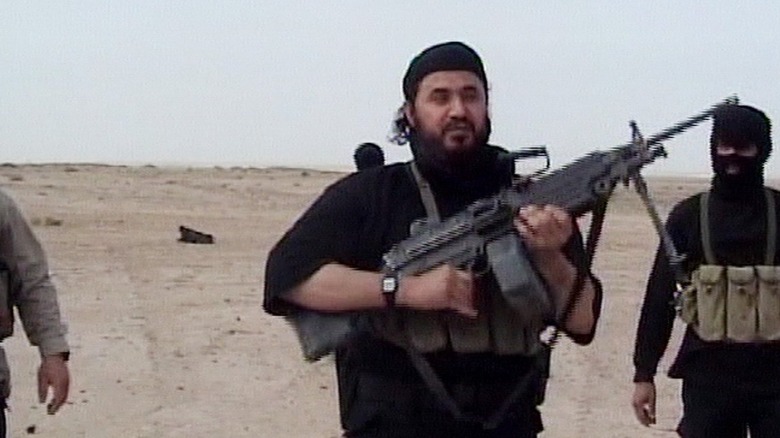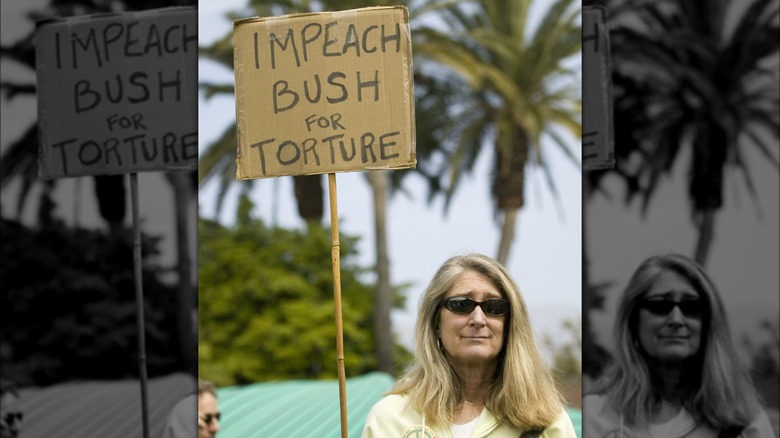The Untold Truth Of The 24th Special Tactics Squadron
As one of the most top-secret and highly classified units in the United States military, the 24th Special Tactics Squadron (24STS) has a decorated, but also mysterious, history. The 24STS is part of the U.S. Air Force, and since April 2011 it has served within the 724th Special Tactics Group under the 24th Special Operations Wing. The 24STS also makes up a quarter of the Joint Special Operations Command, or JSOC, alongside Delta Force, SEAL Team 6 (ST6), and the Army's Intelligence Activity group. Unlike their highly-trained counterparts such as Delta Force or ST6 — who each have extensive media coverage — the 24 STS does have nearly the same recognition or fame.
Yet, the 24STS is every bit as important and fierce, and they have quite the track record to prove it. The 24STS dates all the way back to 1941 during the Second World War, when they were first known as the 24th Air Corps Interceptor Control Squadron. The Army deactivated the unit in 1944 before the war ended, and they did not officially bring it back until 1987, and in 1992 it became the 24STS.
Since returning, the 24STS has participated in numerous missions, including the 1989-1990 Invasion of Panama, the 1993 intervention in Somalia, and the wars in both Iraq and Afghanistan in the 21st century. They are one of the elite fighting forces in American history, and this is their untold truth.
The 24STS helped run radar during World War II
The history of the 24th Special Tactics Squadron (24STS) officially began during World War II on October 14, 1941, when they were first constituted under the banner of the 24th Air Corps Interceptor Control Squadron (24ICS). Back then, the Air Force was still just a smaller wing of the United States Army, known as the U.S. Army Air Force, and the two branches would not be separate until the creation of the Department of the Navy in 1947 after the war was over.
According to Randall DeGering in "Radar Contact! The Beginnings of Army Air Forces Radar and Fighter Control," the 24ICS would later become the 24th Fighter Control Squadron (24FCS) and has the distinction of being the first FCS unit in Army Air Force history. The Army Air Force created the FCS units after the Battle of Britain to work the radar systems and determine which aircraft in the skies above were friendly and which were Axis. Not only would units like the 24FCS use radar to track aircraft, but they also helped guide Allied pilots back to friendly territory through homing stations and radio telephones.
For the most part, the Army Air Force stationed the 24ICS/FCS at Hamilton Field in California, where they worked as part of the San Francisco Air Defense Wing on the West Coast. The unit did not make it to the end of the war, and the Army officially deactivated them on March 31, 1944.
The 24STS is part of JSOC's Tier 1 Unit
It was not until May 1, 1987, that the United States Air Force officially brought back the long-defunct 24th Fighter Control Squadron, which they designated as the 1724th Combat Control Squadron (1724CCS). However, instead of helping to track aircraft, the newly reborn unit entered special forces.
In the mid-1970s, the Air Force had started to experiment with special operations forces under the moniker of "Brand X." By 1981, Brand-X had become Detachment 1, Military Airlift Command Operations Staff, and by 1983, that had evolved to Detachment 4, Numbered Air Force Combat Operations Staff (Det 4, NAFCOS) (via Forrest L. Marion in "Brothers in Berets: The Evolution of Air Force Special Tactics from 1953-2003"). For years, Det 4, NAFCOS was the top of the line for special operations in the Air Force, until it became the 1724CCS in May 1987, which took over the job. The 1724CCS eventually morphed into the 24th Special Tactics Squadron (24STS) by March 1992, which is still their official designation today.
Since 1987, the 24STS has continued to serve as one of the premier special operations forces in the U.S. military. Most notably, the 24STS is a member of the Joint Special Operations Command's (JSOC) Tier One unit. Tier One JSOC is the military's most prestigious special operations force, and the 24STS works with other legendary units like Delta Force and SEAL Team 6 to be one of the most formidable fighting forces on the planet.
They participated in the 1983 botched rescue of hostages in Iran
In November 1979 following the Iranian Revolution, armed militants stormed the United States embassy in Tehran and took dozens of Americans hostage. A month later, the Air Force recruited Capt. John Carney and his upstart Brand X special tactics force for the rescue (via Carney in "No Room for Error: The Covert Operations of America's Special Tactics Units from Iran to Afghanistan").
Carney was part of the planning and worked with CIA technicians and Delta Force's Charlie Beckwith, the mission's head planner. Operation Eagle Claw took about five months to plan from the seizure of hostages in November 1979 to D-Day in April 1980. Carney and six Brand X combat control operators (CCTs) took part and Carney had been responsible for marking the landing zone (LZ) with LED lights prior to kick-off. During the mission, the CCTs worked to organize the LZ for the myriad of vehicles coming in, which proved to be a challenging task due to nighttime and sand.
As they were all landing, one of the helicopters became inoperable, so the mission had to be canceled, Yet, in the midst of trying to withdraw from the crowded LZ, another helicopter crashed into one of the fuel tankers. The tragic explosion killed all three Marines on the helicopter and 45 out of 50 troops on the tanker. Some historians have argued that the CCT's actions may have inadvertently caused the crash, though that is far from conclusive.
[Image by Jtelsa16 via Wikimedia Commons | Cropped and scaled | CC BY-SA 3.0]
They attempted to thwart the infamous Achille Lauro hijacking
On October 7, 1985, the infamous Achille Lauro hijacking occurred, and the U.S. government called on Brand X's successor Detachment 4, Numbered Air Force Combat Operations Staff (Det 4, NAFCOS) to help with the rescue (via Col. John Carney in "No Room for Error"). The Achille Lauro was an Italian cruise liner that was in the midst of a two-week jaunt in the Mediterranean when armed Palestinian terrorists kidnapped nearly 100 passengers at gunpoint at a port in Egypt.
On October 8, things got even darker when the PLF hijackers murdered one of the hostages, a handicapped Jewish-American man in his late 60s named Leon Klinghoffer (pictured above). They callously tossed Klinghoffer into the Mediterranean, and the Joint Special Operations Command (JSOC) thrust into action with nine Det 4, NAFCOS controllers on the team. However, due to inexplicable delays, by the time the JSOC force was in position, not only had the Navy lost the radar location of the ship, but Klinghoffer was dead. After finally arriving, a small team of Navy SEALs and Det 4. NAFCOS controllers almost boarded the ship at sea, but they had to call it off after again losing it on radar.
The delay proved to be extremely costly and ultimately led to the mission's failure. After JSOC was not able to interdict the ship with the terrorists onboard, an Italian court gave them somewhat lenient sentences, and Klinghoffer's killer escaped a life sentence for murder.
They pranked a commander by infiltrating a golf course – twice
Back when the 24th Special Tactics Squadron was still known as Detachment 4, Numbered Air Force Combat Operations Staff (Det 4, NAFCOS), they played an epic prank on their commander Gen. Thomas E. Ryan. Back in 1985, Gen. Ryan was preparing to retire from the Air Force upon the elevation of Lt. Gen. Duane Cassidy to his position at the head of the Military Airlift Command.
When the head of Det 4. NAFCOS Carney heard about the retirement, he planned a high-altitude, low-opening (HALO) parachute jump to surprise both Cassidy and Ryan while they were out golfing at the course at Scott Air Force Base in Illinois (via Col. John Carney in "No Room for Error"). The plan worked, and Carney and his team met the pair on the 15th hole while Ryan was putting, and they presented the retiring leader with a silver-plated pistol. The stunt boosted the reputation of Det 4, NAFCOS within the Air Force, but Cassidy later chewed out Carney over the stunt and its potential public relations repercussions.
Funny enough, this wasn't even the first time Carney had done a stunt like that. In 1983, he had pulled a similar feat, when he and a few controllers donned scuba gear and surprised Cassidy after emerging from a swamp — coincidentally also on the 15th hole. Luckily, Cassidy started laughing when it happened, which may have been why Carney tried it again a few years later.
They participated in the capture Manuel Noriega
In late 1989, the United States government decided to invade Panama to remove the country's dictator since 1983, Manuel Noriega. Noriega was a former CIA informant, but he was also a notorious drug trafficker under U.S. indictment since 1988. After Noriega invalidated the 1989 Panama presidential elections and his forces killed a U.S. Marine, the U.S. went after him.
The 24th Special Tactics Squadron was among the U.S. forces that landed in December 1989 as part of Operation Just Cause. By then, they had the designation of 1724th Special Tactics Squadron (1724STS), after being officially reactivated in 1987. As John Carney explains in "No Room for Error," the 1724STS entered Panama as a combined task force with the 1723rd Special Tactics Squadron (1723STS). However, the two units had never trained together, and there was some antagonism between them.
Things got off to a poor start when the 1724STS' transports failed to pick them up, necessitating a 5-hour car trip to another location. Then, after they jumped into Panama, they were bombarded with air drops of another 2,100 airmen from the 82nd Airborne Division, which threw everything into chaos. One group led by 1724STS controller Mike Lampe assaulted the Rio Halo airfield, capturing it and killing 34 Panamanians. The Army has never officially acknowledged the 1724STS' participation in the operation, but dozens of controllers fought as part of the special forces group.
They searched for scud missiles during the Gulf War
From August 1990 through February 1991, the United States launched the first invasion of Iraq in response to Saddam Hussein and Iraq's invasion of Kuwait. Yet, while they had proven themselves in Panama, for some reason the Joint Strategic Operations Command (JSOC) was initially purposefully excluded from participating in the invasion by the head commander Gen. Norman Schwarzkopf (via John Carney in "No Room for Error"). At the time, the 24th Special Tactics Squadron was still under the 1724th Special Tactics Squadron (1724STS) moniker.
When Schwarzkopf finally allowed JSOC's units to get involved, it was to help with the anti-Scud missile hunt (Scud launch site pictured above). For over a month starting on January 18, 1991, Iraq launched dozens of Scud missiles into Israel with the goal of fracturing the invading coalition to Iraq, by getting the Arab partners to turn against the U.S. over their support of Israel. However, JSOC sent in Delta Force augmented with 1724STS controllers, and many credit them with keeping Israel out of the war by destroying the Iraqi Scuds. For every Delta Force team that went out, they carried at least one 1724STS controller who coordinated air strikes for them.
In the end, the controllers would be invaluable to the missions, saving countless patrols from total destruction and preserving many American lives. The introduction of U.S. special forces stopped Hussein's launching of Scud missiles into Israel cold and likely prevented the war from expanding exponentially.
They played a big role during the 1993 fighting in Somalia
In August 1993, the newly minted 24th Special Tactics Squadron (24STS) quickly saw some of their first action fighting in the Somali Civil War. The air force sent an 11-man force from the 24STS over to Somalia after fighting broke out between Somali militants and United Nations forces sent to protect food deliveries to poor communities. U.S. forces had arrived initially in December 1992 and seemed to be on their way out by May 1993, so they shifted responsibility to UN forces, but then the fighting started in June.
The 24STS controllers arrived as part of a Joint Special Operations Command group called Task Force Ranger (TFR). In August and September, several 24STS controllers participated in various raids and skirmishes, including the capture of an advisor to warlord Mohammad Aideed, the main Somali militant antagonist. In October, TFR participated in the famous Battle of Mogadishu (the later basis of the film "Black Hawk Down").
Two 24STS controllers, MSgt. Scott Fales and TSgt. Tim Wilkinson (portrayed by Ty Burrell, above), earned the Silver Star and Air Force Cross respectively for their actions in helping to rescue a helicopter team that had crash-landed. The pair risked their life under heavy fire and provided medical care, and Fales suffered an injury. In addition, five other 24STS controllers earned medals, including the Silver Star and the Bronze Star with Valor, for their actions.
There have been some tragic accidents
Even though the 24th Special Tactics Squadron (24STS) is one of the most prestigious units in the entire United States military, that does not mean its controllers are immune from devastating accidents. Two of the most notable disasters involving 24STS controllers occurred in February 2007 and August 2011, respectively, and involved the deaths of four men.
On February 17, 2007, TSgt. Scott E. Duffman of the 24STS was part of a contingent of 21 personnel fighting in Afghanistan when their MH-47 helicopter crashed, killing Duffman and seven others. Duffman had been deployed to Afghanistan less than a week when the helicopter crashed after a mechanical problem on the way from Kandahar to Bagram, and he left behind both a wife and an infant daughter. There was another controller and two pararescuemen onboard the MH-47 who survived, and they may have been part of the 24STS attachment, too.
The other crash happened four years later on August 6, 2011, and killed 24STS pararescuemen TSgt. Daniel L. Zerbe and TSgt. John W. Brown, and 24STS controller SSgt. Andrew W. Harvell. This crash also occurred in Afghanistan but in Maidan Wardak Province. Taliban fighters shot down their MH-47 chopper after they had rescued an Army Ranger, and 22 others died in the crash. All of the casualties in the crash were special forces soldiers, and Zerbe, Brown, and Harvell were all highly decorated at the time of their deaths.
They were part of the hunt for Osama Bin Laden
Following the September 11, 2001 terrorist attacks in New York City, the United States launched an all-out manhunt to capture the chief architect of the massacre, Osama Bin Laden, as well as the ruling power in Afghanistan where he was hiding, the Taliban. Once again, the 24th Special Tactics Squadrons (24STS) had their hands all over the special operations taking place. Their main job was to be the first forces on the ground to clear landing strips for incoming aircraft (via Sean Naylor in "Relentless Strike: The Secret History of Joint Special Operations Command").
As part of their missions, the 24STS fighters executed numerous high-altitude, low-opening (HALO) parachute jumps, which are incredibly dangerous. What's more, some of the controllers had to wear extra bundles full of supplies like water and medicine, which made the already difficult jump even more precarious and would sometimes result in severe injuries. After landing, the 24STS men would use a penetrometer to make sure it was suitable for heavy aircraft, and the teams operated throughout Afghanistan for several months during the hunt.
In addition, there was also at least one 24STS controller who fought during the Battle of Tora Bora and ordered heavy air strikes on Bin Laden while he was hiding in the Tora Bora caves, though they were not ultimately successful. The 24STS controllers worked closely with Delta Force in Afghanistan, their Joint Special Operations Command partner, to great success.
The story of TSgt. John Chapman
Within the 24th Special Tactics Squadron, few names carry the same weight as TSgt. John Chapman. Born in 1965 and a native of Massachusetts, Chapman is considered by some to be one of the most courageous and brave men to ever wear a U.S. Air Force uniform.
In March 2002, Chapman was part of a special forces unit along with several SEAL Team 6 (ST6) operators, who participated in an assault against Al-Qaeda on Afghanistan's Takur Ghar Mountain in the Shahi-Kot Valley. During the assault, a teammate was trapped behind enemy lines, and Chapman and the unit tried to rescue him. Chapman repeatedly put himself in harm's way, taking on the enemy from open positions and drawing fire away from his teammates. Though it's disputed, the Air Force contends that even after ST6 thought he was dead, he managed to continue to fire at the Al-Qaeda fighters for several minutes, saving many of their lives as they escaped. This was despite being wounded in both the upper and lower body, and his actions helped cover a helicopter full of teammates.
However, SEAL Team 6 argues that he was already deceased when they tried to escape, though the other possibility of an Al-Qaeda member mistakenly firing at his own team appears much less likely. The Air Force originally gave Chapman the Air Force Cross, making him the first combat controller to earn the award, which was upgraded to the Medal of Honor in 2018 in recognition of his heroics.
A 24STS controller earned one of the first Air Force Combat Action Medals
When the United States Air Force created the Air Force Combat Action Medal (AFCAM) in 2007, one of the inaugural recipients was the former 24th Special Tactics Squadron (24STS) pararescueman CMSGt. Ramon Colon-Lopez (pictured above). Colon-Lopez served with 24STS for seven years from February 1999 until January 2005 as a Special Tactics Element Leader (via the U.S. Air Force). On March 11, 2004, Colon-Lopez was fighting in Afghanistan with the 24STS as part of an Advance Force Operations Team.
Colon-Lopez and his team were working alongside the Afghanistan Army trying to disrupt a possible chemical weapons facility when they ran into heavy enemy fire as they were landing their helicopter (via the Department of Defense). Showing incredible tact and bravery, Colon-Lopez charged at the enemy under heavy fire, helping lead his team through the successful mission, which netted multiple enemy KIAs as well as some prisoners and the destruction of enemy equipment.
The Air Force only gave the AFCAM to six airmen when they first introduced it, and Colon-Lopez was the only 24STS veteran to get one. Though the heroics came in 2004, the Air Force did not conceive the award until 2007, and Colon-Lopez and the others received theirs during a ceremony held on June 12, 2007.
The first air force casualty in the Iraq War was a 24STS controller
In April 2003, 24th Special Squadron Tactics (24STS) combat controller (CCT) SSgt. Scott D. Sather became the first member of the U.S. Air Force to die during the ongoing Operation Iraqi Freedom. Born in 1973 in Flint, Michigan, Sather had been with the 24STS since 1999 after previously being a member of the 22nd Special Tactics Squadron. He was a highly decorated CCT at the time of his death, having accumulated multiple awards over his decade-plus of service.
As part of a larger Joint Special Operations Task Force with other special forces fighters, Sather was making an assault in northern Baghdad when a terrible tragedy happened. During the fighting, Sather's Humvee for some reason positioned itself in front of friendly tanks, who apparently did not realize they were teammates and mistakenly fired on them (via Sean Naylor in "Relentless Strike"). The blast obliterated the Humvee and killed Sather, marring an otherwise successful operation.
However, other sources dispute whether or not that was how Sather was killed, and whether it was April 8 or 9, 2003. According to the National Museum of the U.S. Air Force, Sather died as a result of "direct enemy fire," and the U.S. military has never acknowledged otherwise. Regardless, in 2012 the Air Force dedicated a memorial to him at the Sather Air Base in San Antonio, Texas, noting his heroic sacrifice.
They helped capture the founder of ISIL
For several years leading up to his capture, Jordanian terrorist Abu Musab al-Zarqawi was near the top of the U.S. military's list of wanted men. Al-Zarqawi was an associate of infamous terrorist Osama Bin Laden, and he was active in Iraq in 2003 following the September 11th terrorist attacks working on behalf of Bin Laden and Al-Qaeda. U.S. intelligence officials had linked him directly to several deadly attacks, and they had a $25 million reward for his capture.
During his reign of terror, Zarqawi was insistent on creating a new Islamic caliphate inside Iraq, and he was a frequent poster on social media websites promoting Islamic militantism. To find and kill him, the U.S. military created Task Force 145, which consisted of members from Delta Force, SEAL Team 6, the 75th Ranger Regiment, and the 24th Special Tactics Squadron. For months leading up to his June 7, 2006 death, Task Force 145 was hot on his tail and almost got to him numerous times, though he was able to escape.
Finally, in early June, officials located him in northern Baghdad and took him out with a deadly air strike, and by then he had been the most wanted man in the country for some time. After his death, his group of followers renamed themselves the Islamic State of Iraq and the Levant, also known as ISIL.
They may have been involved in torture
While the 24th Special Tactics Squadron (24STS) has earned many accolades over the years for its performance in various missions, there are also some disturbing allegations that have been leveled against some of its members, too. During the fighting in Iraq and Afghanistan since the early 2000s, 24STS members have been part of numerous Joint Strategic Operations Command (JSOC) task forces, including Task Forces 121, 6-26, and 145.
However, a 2006 Human Rights Watch (HRW) report titled "No Blood, No Foul: Soldiers' Accounts of Detainee Abuse in Iraq," alleges some damning accusations against the task forces. While the report does not specify any members of the 24STS, it cites eyewitness reports describing various methods of physical and psychological torture that interrogators associated with the task forces carried out. These include the use of a "black room," physically assaulting detainees with kicks and punches, blasting loud music and strobe lights, sleep deprivation, or forcing them to stay in stressful physical positions for extended periods.
The New York Times reported that at one of the detention centers inside the Baghdad International Airport, there was a sign with the phrase "NO BLOOD, NO FOUL." This was to mean that torture was okay as long as it did not draw any blood, because the abuser could not be prosecuted. There have been no known prosecutions of 24STS members for human rights abuses, but the report is a horrific stain on the unit.
